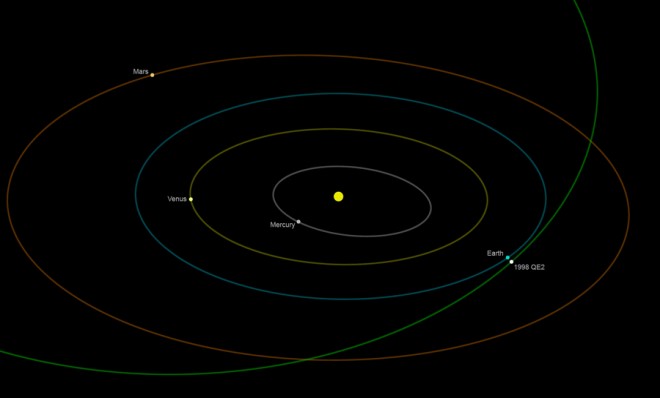The asteroid flying by Earth has its own baby moon
Meet 1998 QE2

At 5 p.m. EST, a large asteroid 1.7 miles in diameter is set to whiz past Earth, giving NASA scientists their best chance to date to study an asteroid up close. And better still: The space rock is towing some teeny-tiny company.
1998 QE2, as scientists have dubbed it, is a binary asteroid that's being orbited by a satellite: Its own 2,000-foot-wide mini-moon. It was first spotted by Marina Brozovic, a scientist at NASA's Jet Propulsion Lab in Southern California. She used radar images taken from the Deep Space Network antenna when the asteroid was still 3.75 million miles away.
Which isn't to say scientists are all that surprised. According to NASA, 16 percent of asteroids bigger than 655 feet have binary or even ternary systems.
The Week
Escape your echo chamber. Get the facts behind the news, plus analysis from multiple perspectives.

Sign up for The Week's Free Newsletters
From our morning news briefing to a weekly Good News Newsletter, get the best of The Week delivered directly to your inbox.
From our morning news briefing to a weekly Good News Newsletter, get the best of The Week delivered directly to your inbox.
Named for the year it was discovered, 1998 QE2's arrival represents a major notch in the belt of NASA's Near-Earth Object tracking program, which is charged with mapping the thousands of high-speed asteroids in our solar system in case one is headed our way. "It's one of the initial successes of our effort to find the big asteroids that could hit the Earth and cause global catastrophe," Paul Chodas, a scientist with the project, tells CNN. To date, NASA astronomers have identified only 10 percent of the 10,000 objects they believe will zoom by our planet in the coming decades.
1998 QE2 is a big one, too. (In the radar imagery above, one fuzzy pixel is calculated to represent 250 feet.) It's massive enough to easily wipe out a major metropolitan area.
Luckily, when the asteroid passes by Earth on Friday, it will still be about 3.6 million miles away — 15 times the distance to the moon — and we won't have to worry about it again for at least another 200 years.
However, "for an asteroid of this size," says Chodas, "it's a close shave."
A free daily email with the biggest news stories of the day – and the best features from TheWeek.com
-
 Cryptocurrency and the future of politics
Cryptocurrency and the future of politicsIn The Spotlight From electoral campaigns to government investments, crypto is everywhere and looks like it’s here to stay
-
 Ssh! UK libraries worth travelling for
Ssh! UK libraries worth travelling forThe Week Recommends From architectural delights to a ‘literary oasis’, these are some of the best libraries around the country
-
 A fentanyl vaccine may be on the horizon
A fentanyl vaccine may be on the horizonUnder the radar Taking a serious jab at the opioid epidemic
